加拿大历史英文介绍
- 格式:ppt
- 大小:103.50 KB
- 文档页数:4


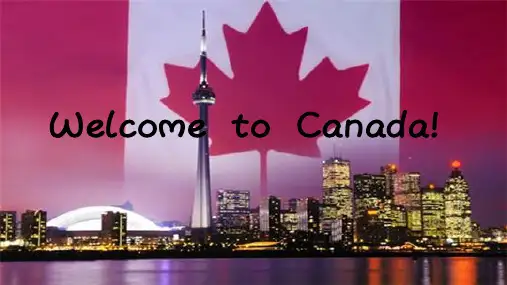
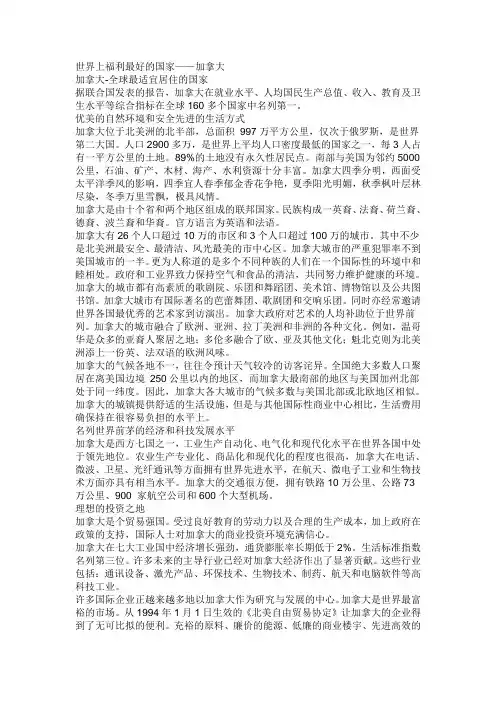
世界上福利最好的国家——加拿大加拿大-全球最适宜居住的国家据联合国发表的报告,加拿大在就业水平、人均国民生产总值、收入、教育及卫生水平等综合指标在全球160多个国家中名列第一。
优美的自然环境和安全先进的生活方式加拿大位于北美洲的北半部,总面积997万平方公里,仅次于俄罗斯,是世界第二大国。
人口2900多万,是世界上平均人口密度最低的国家之一,每3人占有一平方公里的土地。
89%的土地没有永久性居民点。
南部与美国为邻约5000公里,石油、矿产、木材、海产、水利资源十分丰富。
加拿大四季分明,西面受太平洋季风的影响,四季宜人春季郁金香花争艳,夏季阳光明媚,秋季枫叶层林尽染,冬季万里雪飘,极具风情。
加拿大是由十个省和两个地区组成的联邦国家。
民族构成一英裔、法裔、荷兰裔、德裔、波兰裔和华裔。
官方语言为英语和法语。
加拿大有26个人口超过10万的市区和3个人口超过100万的城市。
其中不少是北美洲最安全、最清洁、风光最美的市中心区。
加拿大城市的严重犯罪率不到美国城市的一半。
更为人称道的是多个不同种族的人们在一个国际性的环境中和睦相处。
政府和工业界致力保持空气和食品的清洁,共同努力维护健康的环境。
加拿大的城市都有高素质的歌剧院、乐团和舞蹈团、美术馆、博物馆以及公共图书馆。
加拿大城市有国际著名的芭蕾舞团、歌剧团和交响乐团。
同时亦经常邀请世界各国最优秀的艺术家到访演出。
加拿大政府对艺术的人均补助位于世界前列。
加拿大的城市融合了欧洲、亚洲、拉丁美洲和非洲的各种文化。
例如,温哥华是众多的亚裔人聚居之地;多伦多融合了欧、亚及其他文化;魁北克则为北美洲添上一份英、法双语的欧洲风味。
加拿大的气候各地不一,往往令预计天气较冷的访客诧异。
全国绝大多数人口聚居在离美国边境250公里以内的地区,而加拿大最南部的地区与美国加州北部处于同一纬度。
因此,加拿大各大城市的气候多数与美国北部或北欧地区相似。
加拿大的城镇提供舒适的生活设施,但是与其他国际性商业中心相比,生活费用确保持在很容易负担的水平上。
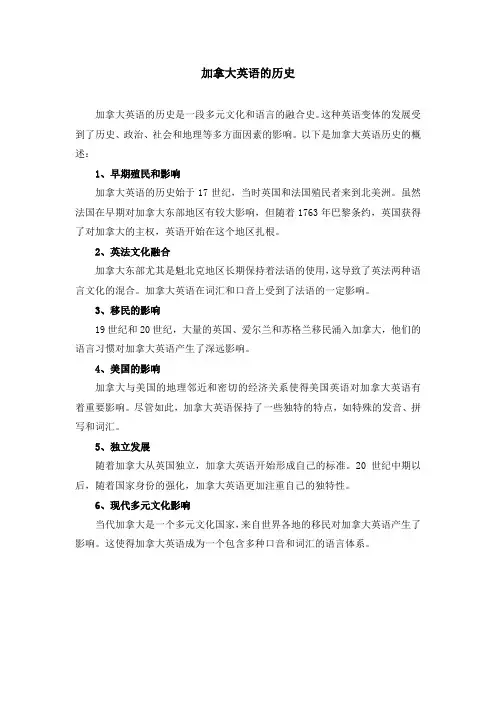
加拿大英语的历史
加拿大英语的历史是一段多元文化和语言的融合史。
这种英语变体的发展受到了历史、政治、社会和地理等多方面因素的影响。
以下是加拿大英语历史的概述:
1、早期殖民和影响
加拿大英语的历史始于17世纪,当时英国和法国殖民者来到北美洲。
虽然法国在早期对加拿大东部地区有较大影响,但随着1763年巴黎条约,英国获得了对加拿大的主权,英语开始在这个地区扎根。
2、英法文化融合
加拿大东部尤其是魁北克地区长期保持着法语的使用,这导致了英法两种语言文化的混合。
加拿大英语在词汇和口音上受到了法语的一定影响。
3、移民的影响
19世纪和20世纪,大量的英国、爱尔兰和苏格兰移民涌入加拿大,他们的语言习惯对加拿大英语产生了深远影响。
4、美国的影响
加拿大与美国的地理邻近和密切的经济关系使得美国英语对加拿大英语有着重要影响。
尽管如此,加拿大英语保持了一些独特的特点,如特殊的发音、拼写和词汇。
5、独立发展
随着加拿大从英国独立,加拿大英语开始形成自己的标准。
20世纪中期以后,随着国家身份的强化,加拿大英语更加注重自己的独特性。
6、现代多元文化影响
当代加拿大是一个多元文化国家,来自世界各地的移民对加拿大英语产生了影响。
这使得加拿大英语成为一个包含多种口音和词汇的语言体系。
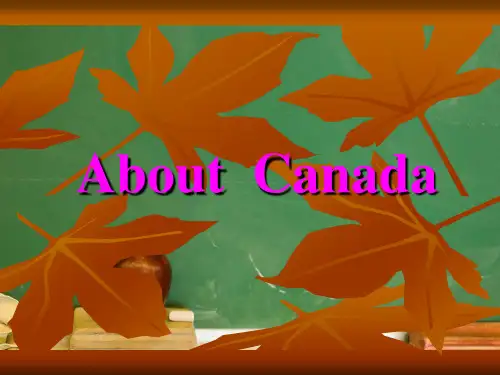

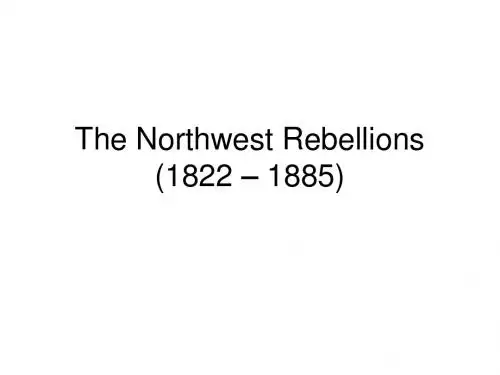
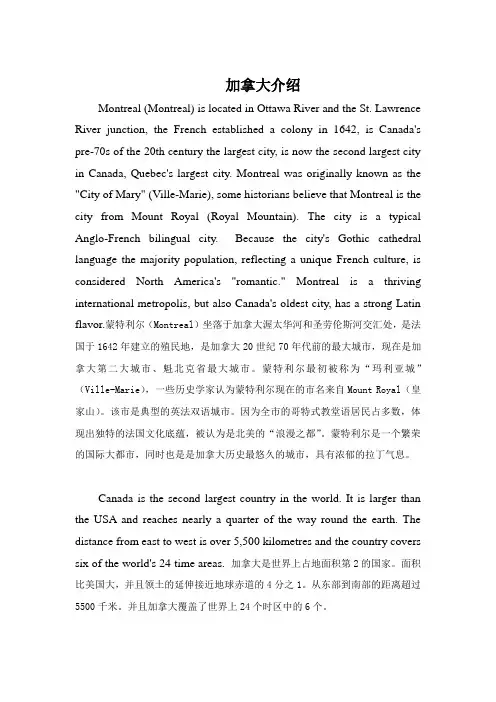
加拿大介绍Montreal (Montreal) is located in Ottawa River and the St. Lawrence River junction, the French established a colony in 1642, is Canada's pre-70s of the 20th century the largest city, is now the second largest city in Canada, Quebec's largest city. Montreal was originally known as the "City of Mary" (Ville-Marie), some historians believe that Montreal is the city from Mount Royal (Royal Mountain). The city is a typical Anglo-French bilingual city. Because the city's Gothic cathedral language the majority population, reflecting a unique French culture, is considered North America's "romantic." Montreal is a thriving international metropolis, but also Canada's oldest city, has a strong Latin flavor.蒙特利尔(Montreal)坐落于加拿大渥太华河和圣劳伦斯河交汇处,是法国于1642年建立的殖民地,是加拿大20世纪70年代前的最大城市,现在是加拿大第二大城市、魁北克省最大城市。
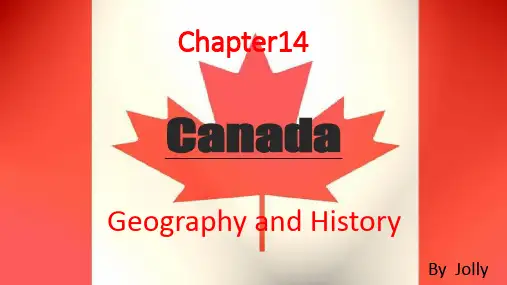
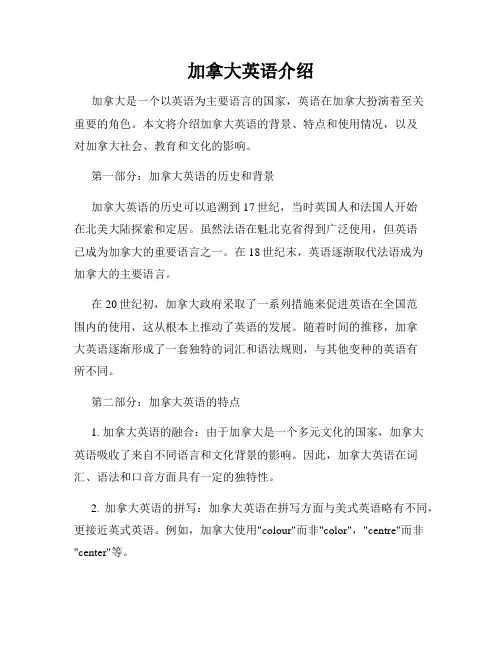
加拿大英语介绍加拿大是一个以英语为主要语言的国家,英语在加拿大扮演着至关重要的角色。
本文将介绍加拿大英语的背景、特点和使用情况,以及对加拿大社会、教育和文化的影响。
第一部分:加拿大英语的历史和背景加拿大英语的历史可以追溯到17世纪,当时英国人和法国人开始在北美大陆探索和定居。
虽然法语在魁北克省得到广泛使用,但英语已成为加拿大的重要语言之一。
在18世纪末,英语逐渐取代法语成为加拿大的主要语言。
在20世纪初,加拿大政府采取了一系列措施来促进英语在全国范围内的使用,这从根本上推动了英语的发展。
随着时间的推移,加拿大英语逐渐形成了一套独特的词汇和语法规则,与其他变种的英语有所不同。
第二部分:加拿大英语的特点1. 加拿大英语的融合:由于加拿大是一个多元文化的国家,加拿大英语吸收了来自不同语言和文化背景的影响。
因此,加拿大英语在词汇、语法和口音方面具有一定的独特性。
2. 加拿大英语的拼写:加拿大英语在拼写方面与美式英语略有不同,更接近英式英语。
例如,加拿大使用"colour"而非"color","centre"而非"center"等。
3. 加拿大英语的口音:加拿大英语的口音因地域和个人而异,但通常被认为与美式英语相似,尽管有一些独特的特点。
例如,在一些加拿大地区,"about"的发音类似于"aboot"。
第三部分:加拿大英语的使用情况1. 官方语言:英语是加拿大的官方语言之一,另一个是法语。
英语广泛使用于政府、教育、商务和媒体等领域。
大多数加拿大人能够流利地使用英语进行日常交流。
2. 加拿大的双语政策:加拿大政府积极推动两种官方语言的发展,鼓励公民学习和使用英语和法语。
法语主要在魁北克省使用,而英语在整个国家范围内广为流行。
3. 英语教育:加拿大拥有一流的英语教育系统,吸引了许多国际学生前往学习。
一、加拿大的历史溯源The origin of Canada加拿大的历史是从印第安和爱斯基摩等原住民的历史开始的,10世纪以后,西欧的足迹才开始踏上这片土地。
最初先是海盗来到加拿大东部,此后从欧洲人进行探险的时代开始一直到近现代,北美大陆的历史在此阶段迅速展开。
The history of Canada started with the aborigine of the Indians and Eskimos.Since the 10th century,the footprints of the Western civilization have started to brand on this new land.The first vistors are a gang of pirates after which , the Europeans have started their expedition and explorations which has been enduring to the contemporary times.16世纪。
法国人梦想发现并统治更多的疆域,扩展他们的贸易范围,并让世界各国信奉他们的信仰。
加拿大原为印第安人与因纽特人居住地。
\ In the 16th century,the French dreamed of discovering and having control over more and more territories as well as widening their trading realm to let their religious belief being accepted all over the world.16 世纪沦为法、英殖民地,1756—1763年期间,英、法在加拿大爆发“七年战争”,法国战败,而1763年的巴黎和约使加拿大正式成为英属殖民地。
加拿大历史简介英文版加拿大历史简介英文版:CanadaFew countries in the world offer as many choices to the traveller as Canada. Whether your passion is skiing, sailing, museum-bing or indulging in exceptional cuisine, Canada has it all. Western Canada is renowned for its stunningly beautiful countryside; Eastern Canada mixes the flavor and charm of Europe with the bustle of trendy New York; wildlife viewing is at its best in Northern Canada; and, everywhere, you will be surprised by how much more there is to this country than just maple syrup and Mounties.However, Canada also has its fair shareof unsavory history. Traces of up to a dozen distinct groups of Inuit (Eskimos –Canada’s indigenous peop les) have been discovered across Canada’s far northern regions. The Inuit maintain that traditional lands were taken from them by force or subterfuge by previous governments, bearing some resemblance to the plight of the Aborigines in Australia.However, there have been some *** all measures to tackle their remonstrations: in 1991, a 350,000 sq km (135,135 sq miles) area of the Northwest Territories was relinquished to the Inuit as the semi-autonomous Nunavut territory; and additional lands and measures of self-government were granted to the territory in 1999. There is certainly room in Canada to acmodate for these peoples: despite Canada’s gigantic size, the country is sparsely populated. Most people congregate around urban centers, and venturing into more remote rural areas, you may well have only the country’s stunning scenery as your panion.Indeed, Canada is so beautifully diverse that it makes it that little bit easier to prehend why so many people fought for possession of it. During the 17th century, the Anglo-French war over Canada ended with the capitulation of the French Canadian capital, Québec, to the besieging forces of the English General Wolfe. The Americans made a number of efforts to seize control of Britain’s Canadian territories after Britis h defeat in the American War of Independence, but failed, and the two countries thereafter evolved along different historical paths. In 1791, Canada was divided between regions occupied by the English-speaking and the longer-established French-speaking munity, but the arrangement did not work and was replaced by a unified system.Canada now promotes itself as a country of peace, most notably in recent times in its opposition to the US-led war against Iraq. Canada governs itself independently but still has the British monarch as its head of state, with relatively little dissent. These factors are typical of a country that somehow succeeds in unifying incredible range: whatever your passion, Canada has a place for it. After all, this country spans six time zones and borders three of the world’s four oceans.GeographyCanada is bordered to the west by the Pacific Ocean and Alaska, to the east by the Atlantic Ocean, to the northeast by Greenland, and to the south by the ‘Lower 48’ of the USA. The polar ice cap lies to the north. The landscape is diverse, ranging from the Arctic tundra of the north to the great prairies of the central area. Westward are the Rocky Mountains, and in the southeast are the Great Lakes, the St Lawrence River and Niagara Falls. The country is divided into 10 provinces and threeterritories. A more detailed description of each province can be found under the separate provincial entries.。
加拿大简介一、简介国名:加拿大(Canada)。
加拿大立国初期的官方全名是加拿大自治领(英文:The Dominion of Canada,法文:Le Dominion du Canada),在20世纪30年代后,联邦政府就停止使用全称。
1967年,英廷正式放弃加拿大自治领的称号。
国旗:加拿大国旗为红白色枫叶旗。
红枫叶代表人民,加素有“枫叶之国”的美誉。
两侧的红色象征太平洋和大西洋;白色象征辽阔的国土。
国徽:加拿大国徽为盾徽。
1921年制定,图案中间为盾形,盾面下部为一枝三片枫叶;上部的四组图案分别为:三头金色的狮子,一头直立的红狮,一把竖琴和三朵百合花,分别象征加拿大在历史上与英格兰、苏格兰、爱尔兰和法国之间的联系。
盾徽之上有一头狮子举着一片红枫叶,既是加拿大民族的象征,也表示对第一次世界大战期间加拿大的牺牲者的悼念。
狮子之上为一顶金色的王冠,象征英女王是加拿大的国家元首。
盾形左侧的狮子举着一面联合王国的国旗,右侧的独角兽举着一面原法国的百合花旗。
底端的绶带上用拉丁文写着“从海洋到海洋”,表示加拿大的地理位置——西濒太平洋,东临大西洋。
国歌:哦!加拿大(O Canada)面积:9984670平方公里,居世界第二位,(仅次于俄罗斯)其中陆地面积9093507平方公里,淡水覆盖面积891163平方公里。
人口:32,507,874人(第35名)。
人口密度为3人/km2 。
其中,英裔居民占42%,法裔占26.7%,其他欧裔占13%,土著居民(印第安人、米提人和因纽特人)约占3%,其余为亚洲、拉美、非洲裔等。
现有华人约109万人。
居民中信奉天主教的占43.2%,信奉基督教新教的占31.8%。
语言:英语、法语首都:渥太华(Ottawa),地处安大略省。
首都地区(包括安大略省的渥太华市、魁北克省的赫尔市和其周围城镇)人口113.2万(2003年),面积4662平方公里。
年平均最高气温15~26℃(7月),最低气温-16~-6℃(1月)。